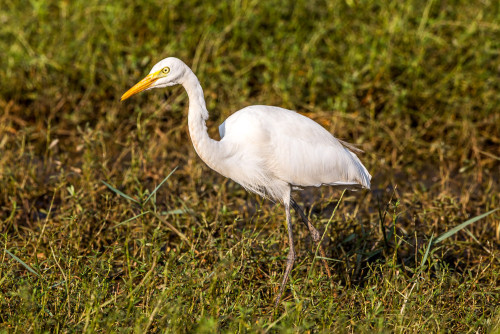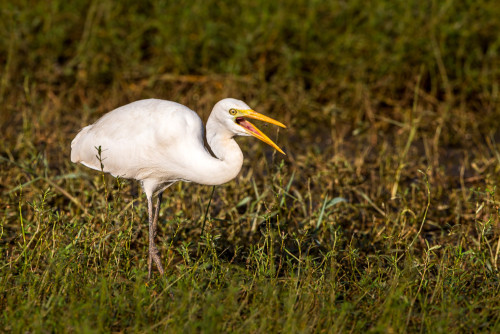
Along with the Black-headed Ibis which was featured in my earlier blog, I also found the Intermediate Egret which was hunting the same marsh a little far away. As the bank of the marsh was very steep I could not get water level angle I wanted to capture. These captures are from top of the banking at close distance and all are full frame except the one above. I used Canon EOS 5D Mark III with Canon EF 500mm f/4L IS II USM Lens + Canon EF 1.4x III Extender on Gitzo GM5541 Carbon Fiber Monopod for this capture.

The intermediate egret, median egret, smaller egret, or yellow-billed egret (Ardea intermedia Wagler, 1829) is a medium-sized heron. As its scientific name implies, this egret is intermediate in size between the great egret and smaller white egrets like the little egret and cattle egret, though nearer to little than great. It has all-white plumage, generally dark legs and a thickish yellow bill. Breeding birds may have a reddish or black bill, greenish yellow gape skin, loose filamentous plumes on their breast and back, and dull yellow or pink on their upper legs (regional variations). The sexes are similar.
Some taxonomists put the species in genus Egretta or sometimes in Mesophoyx, but DNA analyses indicate closer genetic link with Ardea. Hitherto considered conspecific with Ardea. brachyrhyncha and Ardea plumifera, but differs from both during breeding period by having black vs yellow-and-pink bill, much yellower lores and facial area, and black vs reddish tops of legs. It is monotypic.

It is often confused with great & little egret, here are the ways to distinguish them apart from one another. The non-breeding colours are similar to Great egret, but the intermediate is smaller, with neck length a little less than body length, a slightly domed head, and a shorter, thicker bill. The great egret has a noticeable kink near the middle of its neck, and the top of its longer bill nearly aligns with the flat top of its head. Close up, the bare skin of the great egret’s gape line extends in a dagger shape behind the eye, while the Intermediate’s is less pointed and ends below the eye. The intermediate tends to stalk upright with neck extended forward. The great is more patient, often adopting a sideways-leaning “one-eyed” stance.
Whereas little egrets have yellow-soled feet and black bills. They often run after fish in shallow water. Breeding birds have long nuptial plumes on the back of their heads.

It is distributed Pakistan, India and Sri Lanka through SC & SE China to Korea and Japan, and SE Asia to Greater Sundas. Winters to Philippines, Malay Peninsula and Indonesia apparently to Moluccas. North-Asian populations of this species are fully migratory, leaving Japan in September-October to winter in the Philippines and Borneo and returning to breeding colonies in April.
The intermediate egret stalks its prey methodically in shallow coastal or fresh water, including flooded fields. It eats fish, frogs, crustaceans and insects. It often nests in colonies with other herons, usually on platforms of sticks in trees or shrubs. Two to five eggs are laid, the clutch size varying with region.
The species is diurnal and usually feeds singly, but old records suggest that it may form flocks of 15-20 individuals, occasionally forming concentrations around permanent water during droughts.

This species has declined markedly in Japan since the 1960s due to pollution and the disturbance of nesting colonies. The species is also threatened in the Northern Territory of Australia by the degradation of flood-plain habitats owing to grazing, burning, invasion by introduced plants particularly Mimosa pigra and Salvinia molesta which reduced water flows and water diversion for irrigation, clearing of swamp forest, and pollution from mineral extraction.


ಸದ್ಯ ನಾನು ಕಂಡಂತೆ ಕರಾವಳಿಯ ನದಿಮುಖಜಭೂಮಿಗಳು ಸೇರಿದಂತೆ ಎಲ್ಲಾ ಜಲಾಶ್ರಯಗಳಲ್ಲಿ ಸಜೀವಿಗಳನ್ನು ಬೇಟೆಯಾಡುವ ಮೇಲ್ಕಾಣಿಸಿದಂಥ ಹಕ್ಕಿಗಳು ಆಹಾರವಿಲ್ಲದೆ, ಮೃತವಾದರೂ ಸೈ ಎಂದು ತಿನ್ನುವಂಥಾ ಹದ್ದು ಮುಂತಾದವು ಹಾಗೆ ಸತ್ತವನ್ನು ತಿಂದು ಸಾಯುವಂತಾ ವಿಷಮಯ ಸ್ಥಿತಿ ತೀವ್ರವಾಗುತ್ತಿದೆ. ಏನು ಹೇಳಲಿ 🙁
Nice Information Dr. Krishi. Thanks for the writeup